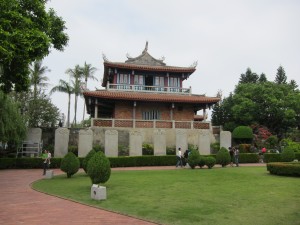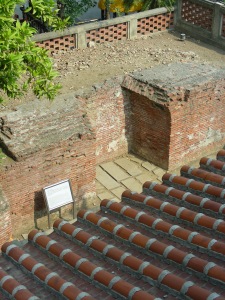TRIP TO SOUTHERN TAIWAN: HISTORICAL TAINAN (台南) PART 3
As its introduction on the $50 entry ticket proclaims, ChihKan Tower is TaiNan’s (台南) most famous historical site. Given the mood lighting installed around the grounds it is possibly its most photographed too.
By Stuart Hill

The Qing Dynasty pavilions now occupy the spot where the Tower of the Red-Haired Barbarians once stood
Originally built by the Dutch as Fort Providentia on land owned by the local aborigines, the site was captured by Koxinga during his takeover of TaiNan in southern Taiwan around 1661. Reportedly destroyed by an earthquake, in 1875 other buildings were constructed on the ruins of the old fort, as an educational and religious center of the Qing Dynasty.
For non-Chinese readers there is not much to explain the meaning of the exhibits in each of the 2 main pavilions, though guidebooks like The Rough Guide to Taiwan provide some interesting facts. However, there is basic English signage around the ChihKan grounds which covers key details.

Taiwan’s history reflects layers of colonial influences, as evidenced by the Dutch foundations of ChihKan Tower
According to the enthusiastic description on the entry ticket, the Chinese name for the site was “The Tower of Red-Haired Barbarians”, but if you’ve been to DanShui’s Fort Domingo, you are probably used to that kind of explanation by now.
The building materials used by the Dutch included bricks imported from Indonesia (another Dutch colony) and XiaMen in China. The buildings and grounds themselves are well maintained and quite picturesque, while remains of the foundations built by the Dutch are evidence of the Dutch effort to turn TaiNan into a major trading outpost based in Taiwan’s south.
Other TaiNan highlights:

Hi Simon, thanks for the question and your kind remarks.
My understanding of the way history has been taught in the schools is a strong focus on China and how Taiwan fits into that story. More recently, there has been a growing interest in aboriginal history, about their beliefs and how they interacted with the various people that came to (colonize) Taiwan too. Those people visiting the sites I have covered throughout this section of the blog are not just foreign tourists. In fact, there hasn’t been a very big tourism industry in Taiwan, except for domestic tourists, until relatively recently. As for archeology, check my story on DanShui, which has a link to an archeology museum at BaLi. Stuart.
Hello Stuart, great articles you are posting and they are proving a valuable source of information on Taiwan’s history. I was wondering what your thoughts are on the general public’s attitude to the type of history you are covering – is that something that is actively looked at or left more as a ‘curiosity for tourists’? Do you see much evidence of archeological research into cities like TaiNan? Regards, Simon